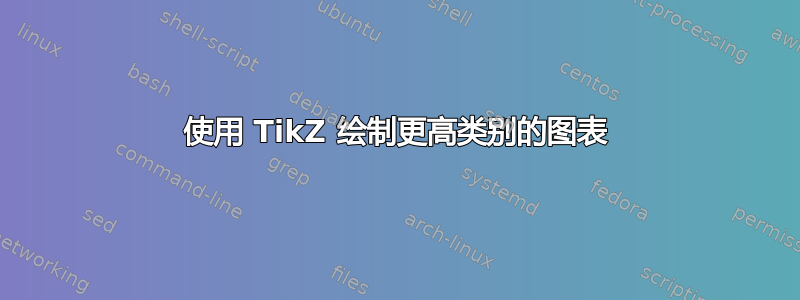
我计划就严格 n 类别进行一次介绍性演讲,并且我想使用 TikZ 通过一些细胞图来展示 k-morphim 之间的关系。
确切地说,我想画出像 Tom Leinster 的书《高等歌剧,高等范畴》前言第六页顶部的四张图一样的图表。 http://arxiv.org/abs/math.CT/0305049

前两个当然很容易。对于第三个,我找到了这个
\begin{tikzcd}
A \arrow[bend left=50]{r}[name=U,below]{} \arrow[bend right=50]{r}[name=D]{} & B \arrow[Rightarrow,to path={(U) -- (D)}]{}
\end{tikzcd}
不幸的是我不知道如何修改代码来绘制最后一个。有什么想法吗?
答案1
像这样吗?
\documentclass{article}
\usepackage{tikz-cd}
\begin{document}
\begin{tikzcd}[column sep=3cm]
a
\arrow[bend left=50]{r}[name=U,below]{}{f}
\arrow[bend right=50]{r}[name=D]{}[swap]{g}
&
b
\arrow[Rightarrow,to path={(U) to[out=-150,in=150] node[auto,swap] {$\scriptstyle\alpha$} coordinate (M) (D)}]{}
\arrow[Rightarrow,to path={(U) to[out=-30,in=30] node[auto] {$\scriptstyle\beta$} coordinate (N) (D)}]{}
\arrow[Rightarrow,to path={([xshift=4pt]M) -- node[auto] {$\scriptstyle\Gamma$} ([xshift=-4pt]N)}]{}
\end{tikzcd}
\end{document}

只需稍微努力一下就可以模仿原始风格:
\documentclass{article}
\usepackage{graphicx}
\usepackage{amssymb}
\usepackage{tikz-cd}
\usetikzlibrary{calc,arrows}
\tikzset{
mydot/.style={circle,fill,inner sep=1.5pt},
commutative diagrams/.cd,
arrow style=tikz,
diagrams={>=latex},
}
\begin{document}
\begin{tikzcd}[column sep=3cm]
\arrow[to path={node[mydot,label={left:$a$}] {}}]{}
\arrow[bend left=50]{r}[name=U,below]{}{f}
\arrow[bend right=50,shorten >= -3.5pt,shorten <= -3.5pt]{r}[name=D]{}{}
\arrow[to path={node[below,yshift=-2pt] at (D) {$\scriptstyle g$} {}}]{}
&
\arrow[to path={node[mydot,label={right:$b$}] {}}]{}
\arrow[Rightarrow,to path={(U) to[out=-160,in=160] node[auto,swap] {$\scriptstyle\alpha$} coordinate (M) (D)}]{}
\arrow[Rightarrow,to path={(U) to[out=-20,in=20] node[auto] {$\scriptstyle\beta$} coordinate (N) (D)}]{}
\arrow[to path={node[label={center:\scalebox{1.9}[0.75]{$\Rrightarrow$}},label={[yshift=-2pt]above:$\scriptstyle\Gamma$}] at ( $ (M)!0.5!(N) $ ) {}}]{}
\end{tikzcd}
\end{document}

答案2
这里有一个仅使用 tikz 的解决方案:
\documentclass[11pt]{scrartcl}
\usepackage[utf8]{inputenc}
\usepackage[T1]{fontenc}
\usepackage{fourier}
\usepackage{tikz}
\usetikzlibrary{arrows,calc}
\begin{document}
\begin{tikzpicture}[>=latex,
every node/.style={auto},
arrowstyle/.style={double,->,shorten <=3pt,shorten >=3pt},
mydot/.style={circle,fill}]
\coordinate[mydot,label=left:$a$](a) at (0,0);
\coordinate[mydot,label=right:$b$](b) at (3,0);
\draw[->] (a) to[bend left=50] coordinate (f) node[]{$f$} (b);
\draw[->] (a) to[bend right=50] coordinate (g) node[,swap] {$g$} (b);
\draw[arrowstyle] (f) to node[right]{$\alpha$} (g);
\coordinate[mydot,label=left:$a$](a) at (6,0);
\coordinate[mydot,label=right:$b$](b) at (11,0);
\draw[->] (a) to[bend left=50] coordinate (f) node[]{$f$} (b);
\draw[->] (a) to[bend right=50] coordinate (g) node[,swap] {$g$} (b);
\draw[arrowstyle] (f) to[bend left=50] node (p){$\beta$} (g);
\draw[arrowstyle] (f) to[bend right=50,swap] node (q){$\alpha$} (g);
\draw[arrowstyle] (q.east) to node[above]{$\Gamma$} (p.west);
\end{tikzpicture}
\end{document}

答案3
这是使用 Metapost 的解决方案。我在网上找不到任何绘制双线和三线的示例,所以我想出了一个使用不同笔宽和的方法undraw。我坚持使用标准 MP 箭头,但只要稍微多做一点工作,我们就可以根据需要将其更改为开放的卷曲箭头。
prologues := 3;
outputtemplate := "%j%c.eps";
vardef double_line_arrow(expr p) =
interim linecap:=butt;
draw p cutafter fullcircle scaled ahlength
shifted point length(p) of p withpen currentpen scaled 3;
undraw p;
filldraw arrowhead p;
enddef;
vardef triple_line_arrow(expr p) =
interim linecap := butt;
draw p cutafter fullcircle scaled (1.5*ahlength)
shifted point length(p) of p withpen currentpen scaled 5;
undraw p withpen currentpen scaled 3;
drawarrow p;
enddef;
beginfig(1);
dotlabel.bot(btex $a$ etex,origin);
endfig;
beginfig(2);
z1 = origin; z2 = right scaled 2cm;
path ab; ab = z1--z2;
drawarrow ab cutafter fullcircle scaled 3 shifted z2;
% stop arrow slightly short of the dotlabel
dotlabel.llft(btex $a$ etex,z1);
dotlabel.lrt (btex $b$ etex,z2);
label.top(btex $f$ etex, point .5 of ab);
endfig;
beginfig(3);
z1 = origin;
z2 = right scaled 2cm;
path ab[];
ab1 = z1{dir 60} .. {dir -60}z2; ab2 = ab1 reflectedabout(origin,right);
drawarrow ab1 cutafter fullcircle scaled 3 shifted z2;
drawarrow ab2 cutafter fullcircle scaled 3 shifted z2;
dotlabel.llft(btex $a$ etex,z1);
dotlabel.lrt (btex $b$ etex,z2);
z3 = point .5 of ab1;
z4 = point .5 of ab2;
label.top(btex $f$ etex,z3);
label.bot(btex $g$ etex,z4);
path fg;
fg = z3 -- z4 cutbefore fullcircle scaled 8pt shifted z3
cutafter fullcircle scaled 8pt shifted z4;
double_line_arrow(fg);
label.rt(btex $\alpha$ etex, point .5 of fg);
endfig;
beginfig(4);
z1 = origin;
z2 = right scaled 2.2cm;
path ab[]; ab1 = z1{dir 60} .. {dir -60}z2; ab2 = ab1 reflectedabout(origin,right);
drawarrow ab1 cutafter fullcircle scaled 3 shifted z2;;
drawarrow ab2 cutafter fullcircle scaled 3 shifted z2;;
dotlabel.llft(btex $a$ etex,z1);
dotlabel.lrt (btex $b$ etex,z2);
z3 = point .5 of ab1;
z4 = point .5 of ab2;
label.top(btex $f$ etex,z3);
label.bot(btex $g$ etex,z4);
path fg[];
fg1 = z3{dir -150} .. {dir -30} z4
cutbefore fullcircle scaled 8pt shifted z3
cutafter fullcircle scaled 8pt shifted z4;
fg2 = fg1 reflectedabout(z3,z4);
z5 = point .5 of fg1;
z6 = point .5 of fg2;
double_line_arrow(fg1); label.lft(btex $\alpha$ etex, z5);
double_line_arrow(fg2); label.rt (btex $\beta$ etex, z6);
ab3 = z5 -- z6
cutbefore fullcircle scaled 4pt shifted z5
cutafter fullcircle scaled 4pt shifted z6;
triple_line_arrow(ab3);
label.top(btex $\Gamma$ etex, point .5 of ab3);
endfig;
end.
该图中从左到右依次为图 1..4。

答案4
自 2020 年起,我们颤动,一个图形化的 tikz-cd 编写器。它特别适合在箭头之间绘制箭头。


